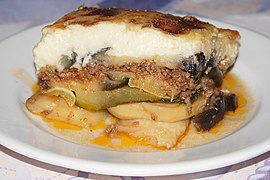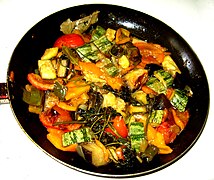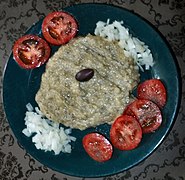Description
🚚 The fastest delivery time : 2-day delivery.
🐝 Supplier / Origin : Various Local Farms / HK
🔖 Certification : Not HKORC Certified / HKORC Certified
🌱 Supplier introduction : We offer local, organic, sustainable options. We use a fair trade price to purchase directly from farmers. The pricing enables producers and consumers to have a sustainable relationship, and the three parties benefit the most.
-
Chinese
yúxiāng-qiézi (fish-fragrance eggplants)
-
Korean
dureup-gaji-
jeon (pan-fried eggplants and angelica tree shoots)
🛍 Product Information :
East Asia
Korean and Japanese eggplant varieties are typically thin-skinned.
In Chinese cuisine, eggplants are known as qiézi (茄子). They are often deep fried and made into dishes such as yúxiāng-qiézi ("fish fragrance eggplant") or di sān xiān ("three earthen treasures"). Elsewhere in China, such as in Yunnan cuisine (in particular the cuisine of the Dai people) they are barbecued or roasted, then split and either eaten directly with garlic, chilli, oil and coriander, or the flesh is removed and pounded to a mash (typically with a wooden pestle and mortar) before being eaten with rice or other dishes.
In Japanese cuisine, eggplants are known as nasu or nasubi and use the same characters as Chinese (茄子). An example of it use is in the dish hasamiyaki (挟み焼き) in which slices of eggplant are grilled and filled with a meat stuffing. Eggplants also feature in several Japanese expression and proverbs, such as "Don't feed autumn eggplant to your wife" (秋茄子は嫁に食わすな, akinasu wa yome ni kuwasuna) (because their lack of seeds will reduce her fertility) and "Always listen to your parents" (親の意見と茄子の花は千に一つも無駄はない, oya no iken to nasu no hana wa sen ni hitotsu mo muda wa nai, literally: "not even one in a thousand of one's parents' opinions or the eggplant flowers is in vain").
In Korean cuisine, eggplants are known as gaji (가지). They are steamed, stir-fried, or pan-fried and eaten as banchan (side dishes), such as namul, bokkeum, and jeon.

🥘 Suggested Recipe:
Indonesian chili terong sauce with shrimp
Minang (West Sumatra) balado terong
Sweet and sour fish head with terong
Simple fried terong from Gorontalo (Sulawesi)
Philippine
ensaladang talong, a salad on grilled and skinned green eggplant
There are many ways to eat it, such as stir-frying, roasting, frying, steaming, mixing, and sautéing. Eggplant is rich in flavonoids, and the content is even richer where the skin and the flesh are connected. The eggplant skin contains a variety of compounds that are beneficial to human health, so it is not recommended to peel it when cooking. There are different eggplant dishes in Asia, Europe and Africa. Traditional Chinese dishes include eggplant boxes, eggplant with garlic paste, fried eggplant with sauce, eggplant with meat slices, braised sweet and sour eggplant, fish-flavored eggplant, salt and pepper eggplant cake, braised eggplant, etc. The local dishes include Beijing's fried eggplant shreds, Shanxi's eggplant in sauce, Hunan's strange-flavored eggplant, Guangdong's eggplant casserole and fried stuffed eggplant, etc. In the Mediterranean region such as Spain, Italy, Greece, Morocco, etc., it is popular Olive oil roasted eggplant.
Penne with eggplant and
basil in yogurt-tomato sauce
Romanian eggplant salad (salată de vinete)
Eggplant is often stewed, as in the French ratatouille, or deep-fried as in the Italian parmigiana di melanzane, the Turkish karnıyarık, or Turkish, Greek, and Levantine musakka/moussaka, and Middle Eastern and South Asian dishes. Eggplants can also be battered before deep-frying and served with a sauce made of tahini and tamarind. In Iranian cuisine, it is blended with whey as kashk e bademjan, tomatoes as mirza ghassemi, or made into stew as khoresht-e-bademjan. It can be sliced and deep-fried, then served with plain yogurt (optionally topped with a tomato and garlic sauce), such as in the Turkish dish patlıcan kızartması (meaning fried aubergines), or without yogurt, as in patlıcan şakşuka. Perhaps the best-known Turkish eggplant dishes are imam bayıldı (vegetarian) and karnıyarık (with minced meat). It may also be roasted in its skin until charred, so the pulp can be removed and blended with other ingredients, such as lemon, tahini, and garlic, as in the Levantine baba ghanoush, Greek melitzanosalata, Moroccan zaalouk and Romanian salată de vinete. A mix of roasted eggplant, roasted red peppers, chopped onions, tomatoes, mushrooms, carrots, celery, and spices is called zacuscă in Romania, and ajvar or pinjur in the Balkans.
🔅 Notes:


























